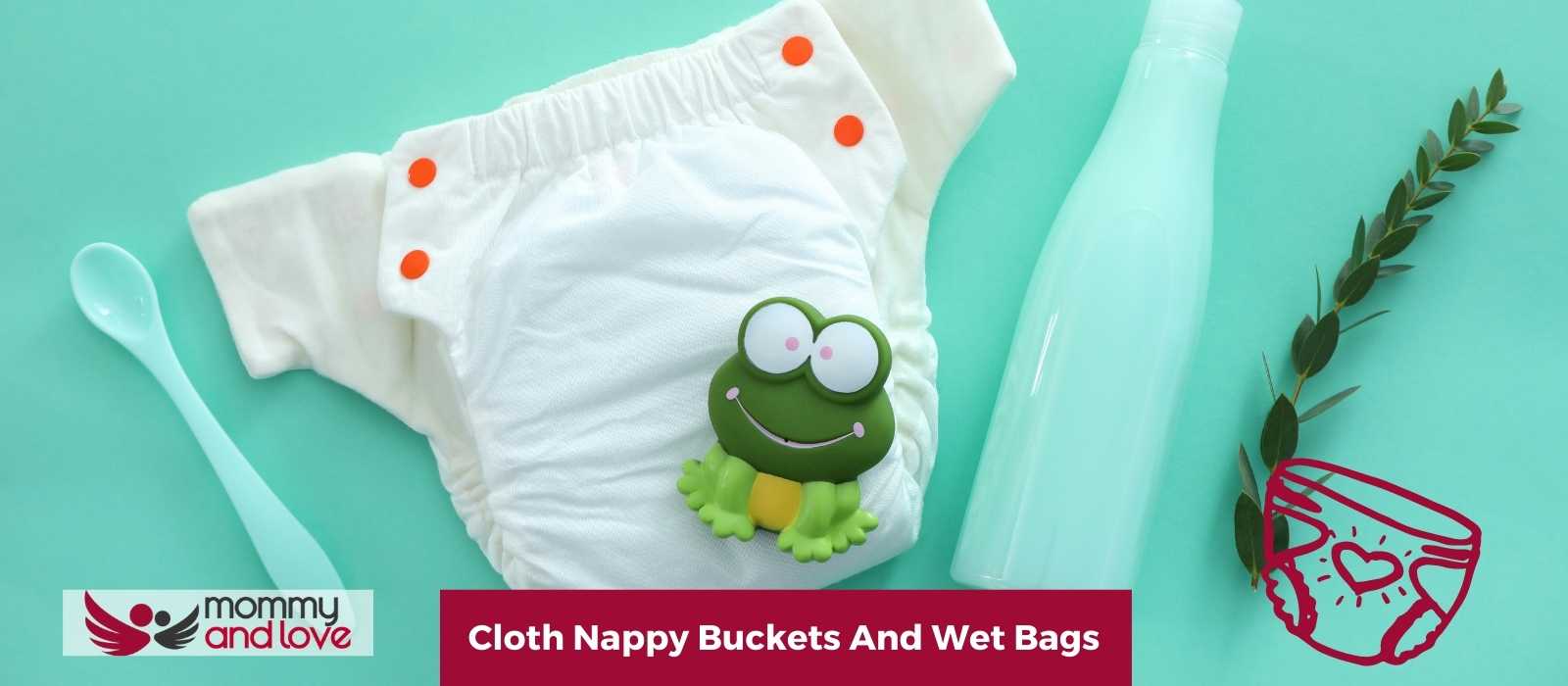Amongst the frequently asked questions when talking about reusable nappies are the concerns about where do you store dirty nappies until you are ready to put them in the washing machine.
Where do you store cloth nappies?
Of course, you aren’t going to throw your used nappy into the bin as you do with a disposable, so what do you do? You can’t just put soiled nappies into your household laundry basket so you need a storage option until wash day.
Similar to everything in life and your reusable nappy journey, there is a choice. The option of using wet bags or a cloth nappy bucket or both. It is all about personal preference and what works best for you.
Cloth Nappy Bucket
A nappy bucket has been a staple part of the accessory pack required for using cloth nappies for many many years. However many people imagine a bucket full of solution with dirty nappies floating about in it.
Although you can still steep nappies, it is not actually necessary with modern cloth nappies and many manufacturers recommend dry pailing, so be sure to check the manufacturer’s guidelines.
Lidded buckets are popular and although you can buy functional buckets like this on the high street, actual nappy pails are larger and designed for the purpose. Using a lidded bucket that is secure will also help keep little hands away from investigating the contents.
If you have a nappy bucket you will also need a mesh bag to line the nappy bin with. We’ve done a detailed guide on mesh laundry bags here.
Mesh bags are also fast becoming a must when using buckets. This acts as a lining that you will be able to use to lift the contents out of the bucket without touching it with your hands and can be washed with your nappies.
Keeping a muslin cloth with a few drops of essential oil at the top of the bucket will help with any lingering smells if you are washing less frequently. Tea tree oil and lavender oil are popular choices.
Popular nappy buckets include the tots bots nappy bucket and the Bambino Mio bucket. In America, these are called a nappy pail, which is where the term dry pailing comes from. If you are unsure about dry pailing, check out our post on that topic.
You can choose to either store your wet nappies in a wet solution or keep them dry in the nappy bucket. The choice of what to do with the soiled nappies is up to you, but these days most people go for the dry pailing option.
What should I look for in a good reusable nappy bucket?
Always try to get a bucket with a tight-fitting lid. It will stop any accidents or any toddlers snooping inside it and touching the used nappies!
A fitted lid will also keep any unwanted smells contained within the nappy pail. A carry handle is also useful for lifting the bucket to the washing machine from the changing station for washing, especially if you are wet pailing! The TotsBots 16L Nappy Bucket has four locks that keep it very safe.
Capacity – your bin should be big enough to take at least 20 nappies, more if you have two in cloth. I think 20l is ideal. The Bambino Mio Nappy Bucket is the ideal size for a full nappy load.
Carbon odor disc – some buckets have de-odorizing discs incorporated into the lid. This is great if you plan on wet pailing your nappies and need to remove the smell.

How do I stop my cloth nappy bin from smelling?
Add a couple of drops of lavender or tea tree oil to the top of the nappy pail lid to make it smell nicer and more pleasant to use. When it comes time to empty the bucket, your nappies will not smell as strongly, and there will be no need to dump dirty water into a sink or bathtub.
Dry pailing can leave a lingering “hamster smell” in the nappy bucket, which can be easily disguised by putting half an inch of water in the sink and adding a couple of drops of lavender oil, then soaking a folded muslin cloth in the liquid.
If necessary, loosely wring the muslin out and then drape it over the top of your nappies in the bucket; when you add new nappies, place them underneath this cover. You’ll have the best-smelling diaper bucket in the entire neighborhood!
Wet Bags for Storing Dirty Nappies
Wet bags are waterproof bags in which you can dry pail your nappies. They come in a range of sizes from small enough for your washable wipes, up to XL which can hold 25-30 nappies. If you are short for space or don’t like the idea of little hands getting easy access to a bucket on the floor, wet bags might be your best solution.
Ensure that you get a Large Hanging Wet/Dry Nappy Wet Bag, big enough for 20 nappies. Smaller ones are idea for out and about.
The great thing about wet bags is their versatility, great as a main storage bag in the house, great for out and about in your changing bag, and even handy for nurseries and child care providers, send two bags in, in the morning- one with clean nappies, one for dirty nappies or you can opt for a wet day bag with a compartment for clean nappies and one for dirty nappies.
With a wide choice of fastenings also available including zip and drawstring options, that is the least of your worries. Wet bags come in such a vast range of prints and colours that there is something to suit everyone’s taste.
Wet bags can also be used for your reusable wipes, feminine hygiene products or dirty baby clothes. The benefit of bags is they can just be thrown in your washing machine and washed with washing powder with the nappies.

So the question now is…which option is best for you?

This article was written by: Gian MIller – Full-Time Writer, Baby Whisperer & Dad of 3.
Gian spends a lot of his time writing. A self-proclaimed baby whisperer, Gian has been through it all with his own children and is passionate about sharing his hard-won wisdom with other parents. When he’s not writing or changing diapers, you can find him playing the guitar or watching baseball (or preferably both at the same time).




